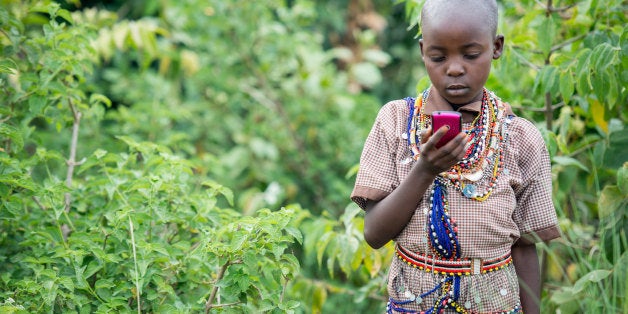
At first glance, the numbers seem staggering. Global mobile phone penetration is 96 percent. In sub-Saharan Africa, where 47 percent of the population lives on less than $1.25 a day, mobile data use is expected to grow twentyfold by the end of 2019, according to a June 2014 mobility study by Ericsson. It is predicted there will be 930 million mobile subscriptions in sub-Saharan Africa by the end of 2019 -- nearly one for every resident. In India, 28 percent of citizens use a mobile phone, with an average of 2.54 devices per user.
But such massive numbers can be deceiving. Mobile phones are often seen as a panacea for improving economic opportunity and public health worldwide. But in reality, we have a long way to go.
According to a Pew Research survey of 24 developing and emerging economies, only two countries had a critical mass of people using mobile phones to make or receive payments: Kenya (68 percent) and Uganda (50 percent). According to the report, "making or receiving payments is one of the least-used cell phone activities," with only 11 percent of the 24,263 people surveyed saying they use mobile devices for that purpose. Likewise, only 15 percent of respondents use mobile phones to get information about health and medicine.
And while mobile adoption is high, Internet use is low. Only 40 percent of the world's population has access to the Internet at all. This is important, because research links Internet use to economic growth. For example, according to one 2010 report, a 10 percent increase in per capita GDP is associated with a 21.5 percent increase in Internet users per capita.
A couple of years ago I wrote about a young man named Stephen Ondieki, who lived in Kenya's second-largest slum. While his neighbors were earning less than $1 a day, Stephen was earning $8 a day running a computer repair shop. Stephen's success would have been impossible without a reliable and affordable broadband connection, which enabled him to take classes that prepared him to repair computers. For Stephen and others in developing countries, broadband connectivity is a powerful catalyst for economic and social advancement.
Yet, 4.2 billion people worldwide are not online. In developing countries only 31 percent of people are online, and in the world's 49 least-developed countries, it is less than 10 percent, according to the International Telecommunication Union's 2013 Measuring the Information Society Report. Smartphones, often a more affordable bridge to Internet access, are still rare in emerging economies; while 59 percent of 18 to 29 year olds in Uganda own a cell phone, only 7 percent own a smartphone.
What are the obstacles? In many parts of the world, high-speed broadband access is simply too expensive. This may be due to a variety of factors, such as lack of competition, poor infrastructure, widespread poverty or regulatory hurdles.
Basic mobile phones can circumvent lack of broadband access, but only to a certain extent. Nelson Mandela said, "Education is the most powerful weapon which you can use to change the world," yet use of mobile for education (m-learning) is still in its infancy and focused on basics like literacy. For example, the nonprofit Worldreader delivers books on mobile devices for free, using a compression technology to achieve high speeds even on low-bandwidth networks. The service is available across the developing world, with high use in sub-Saharan Africa and India.
Yes, mobile is powerful. But can it deliver the robust, specialized training needed to fill in-demand jobs around the world - many of which involve IT skills - and put 75 million unemployed young people to work?
None of this is meant to dismiss the global problem solvers who are doing amazing work with mobile technology. The high mobile payment rate in Kenya can be attributed to Safaricom's M-PESA, a system initially designed to facilitate mobile microfinance loan payments but expanded for broader use. Over 17 million Kenyans use M-PESA and around 25 percent of the country's GNP flows through it. Another example: "micro-entrepreneurs" with Living Goods use mobile phones to market low-cost health and hygiene products in their communities. They earn a livelihood while improving public health.
But the reality is, while mobile phone use is widespread, it is not a silver bullet for economic growth and individual livelihood. We must all work together on two fronts: (1) capitalizing on skyrocketing mobile adoption by developing and advancing truly transformational mobile tools that promote health, financial inclusion and skills development and (2) improving access to high-speed broadband for all the world's people.
By "we," I mean corporations, governments, nonprofits and academia. For example, Worldreader partnered with Australian application developer biNu to deliver its smart phone-like experience to low-end mobile phones. Through its AppLab Incubator, the non-governmental organization (NGO) Grameen Foundation partners with private sector companies like MTN Uganda (telecommunications) and CARD Bank in the Philippines to develop, deliver and test mobile financial products for poor households. In a rural, isolated corner of Africa, Cisco partnered with USAID, local Internet service providers, and several NGOs such as NetHope, to bring high-speed Internet access to the world's largest refugee camp in Dadaab, Kenya. Thanks to this network, humanitarian organizations are saving money on communications and better serving the camp's residents, and refuges are getting educational and vocational training online at one of five community centers inside the camp.
When one person's livelihood changes, it can impact an entire family, then a whole community. When something effective takes hold, it can change the world. Whether through a mobile device or a desktop computer, connectivity and creativity make it all possible.
Read how mobile phones and access to broadband Internet are empowering people to become financially self-sufficient by visiting our site here: http://csr.cisco.com/pages/economic-empowerment-impact-stories